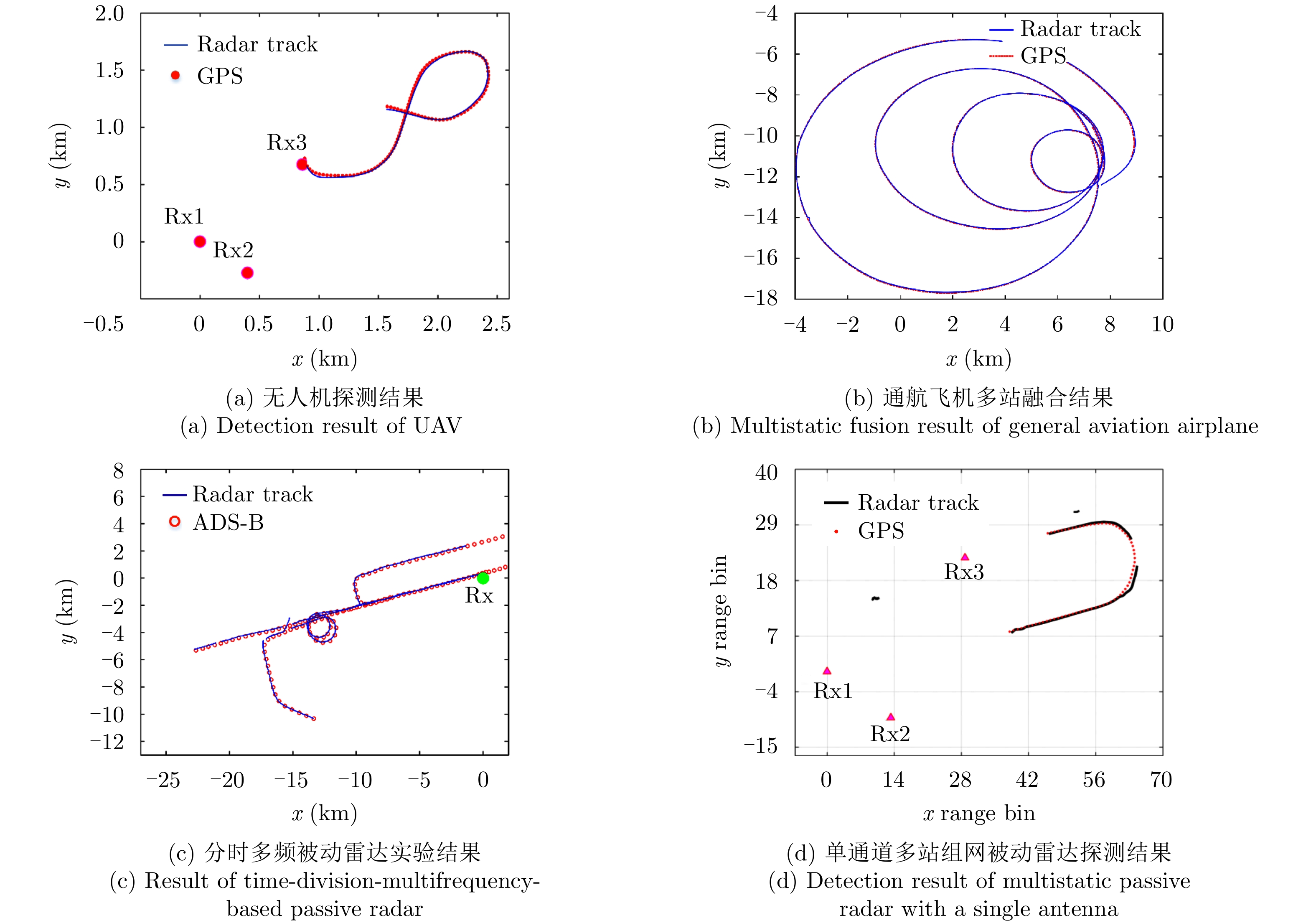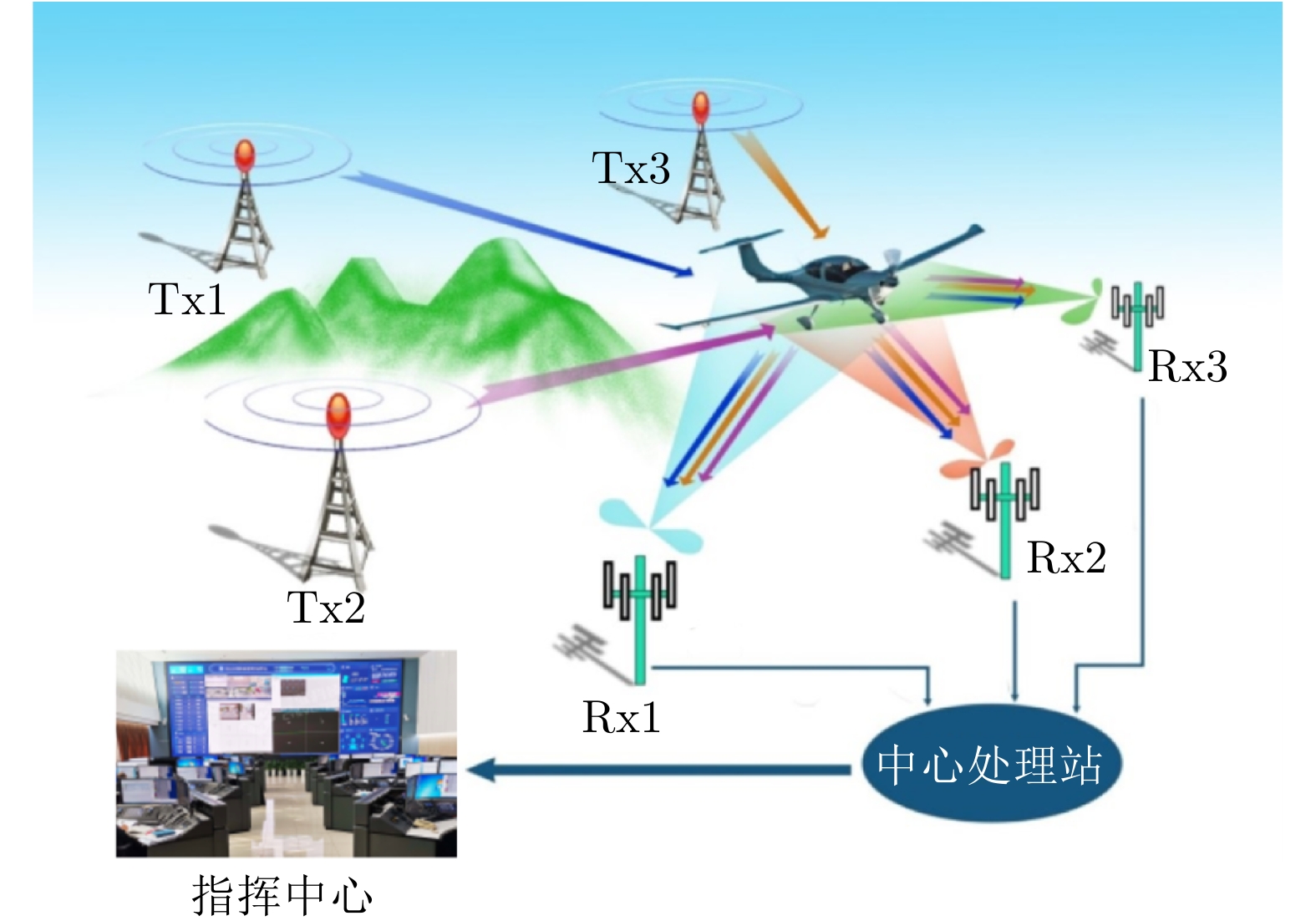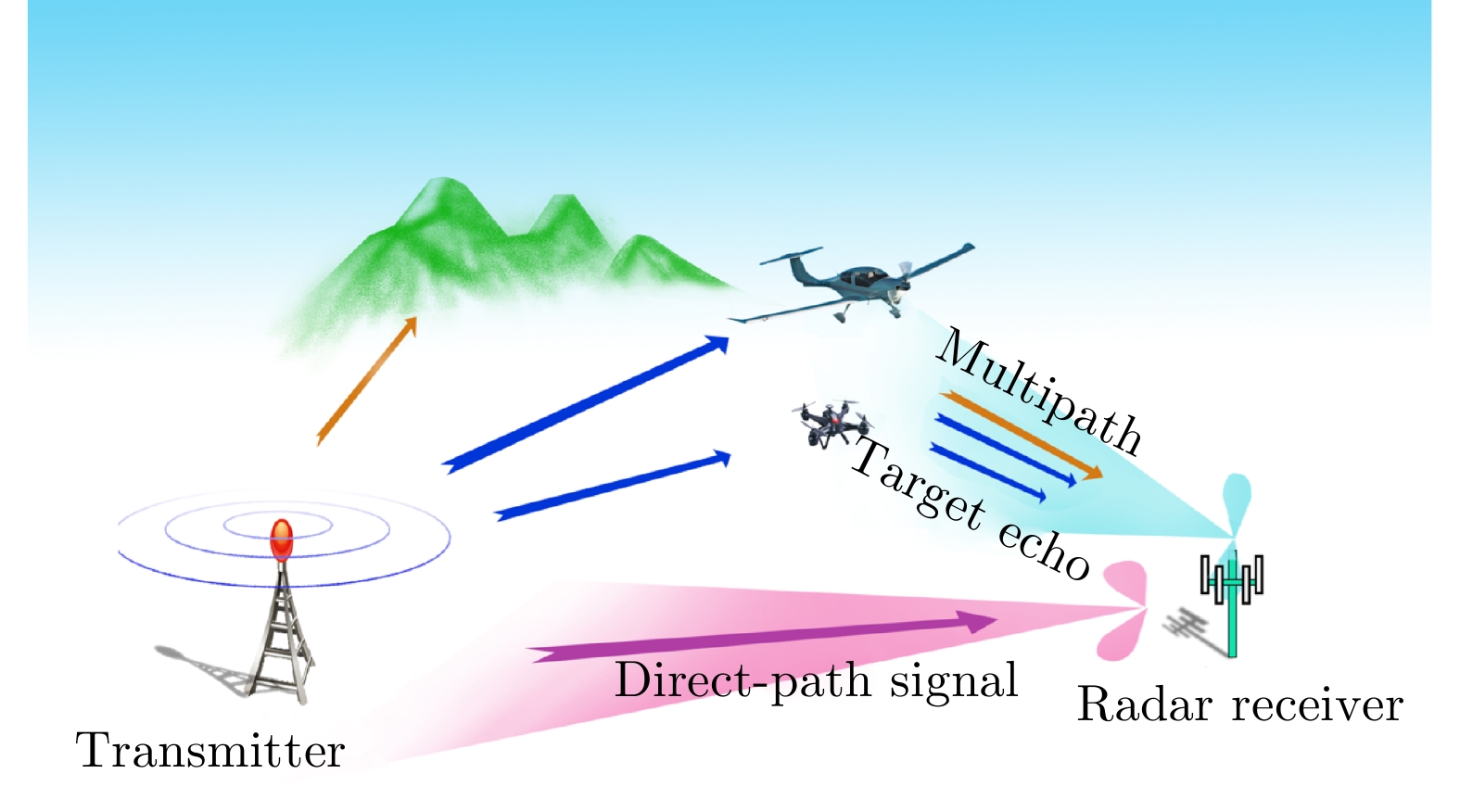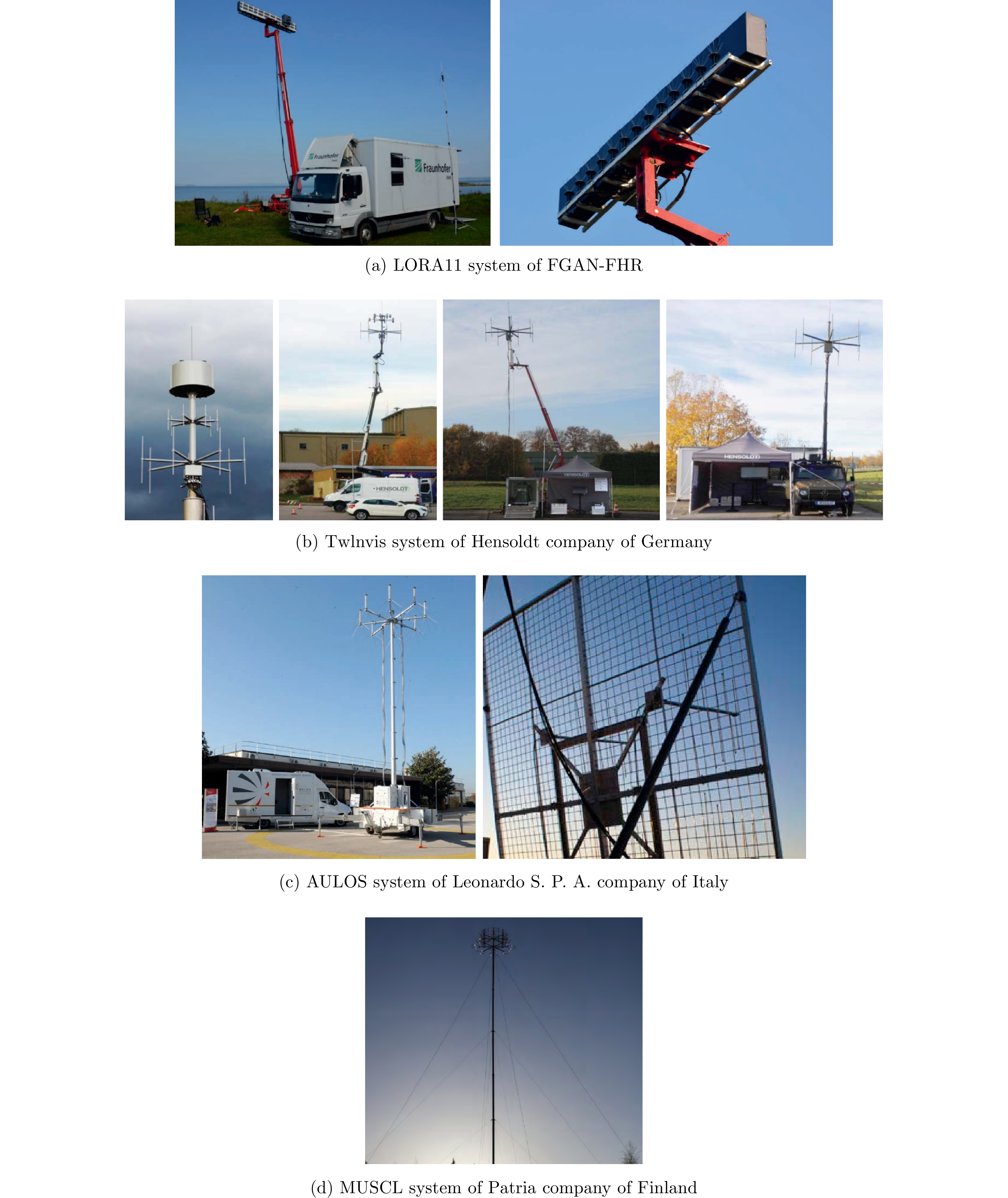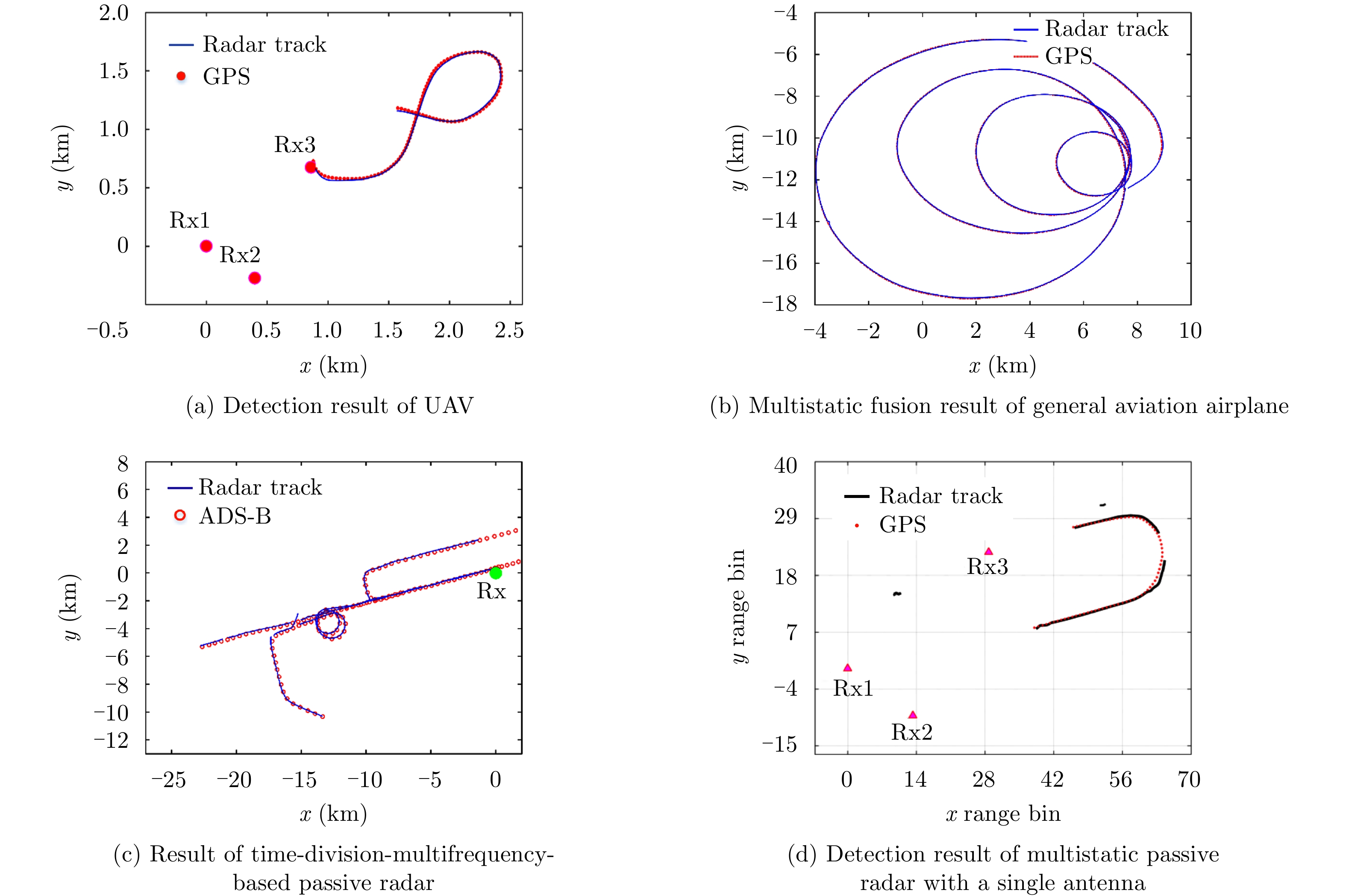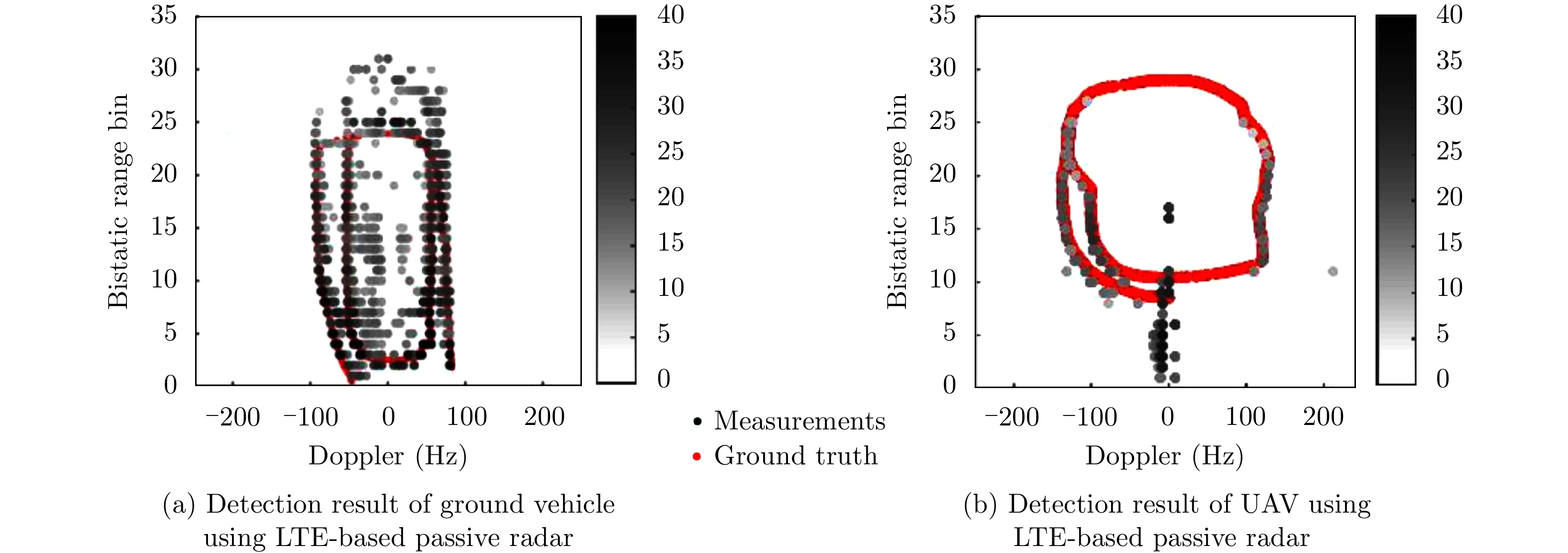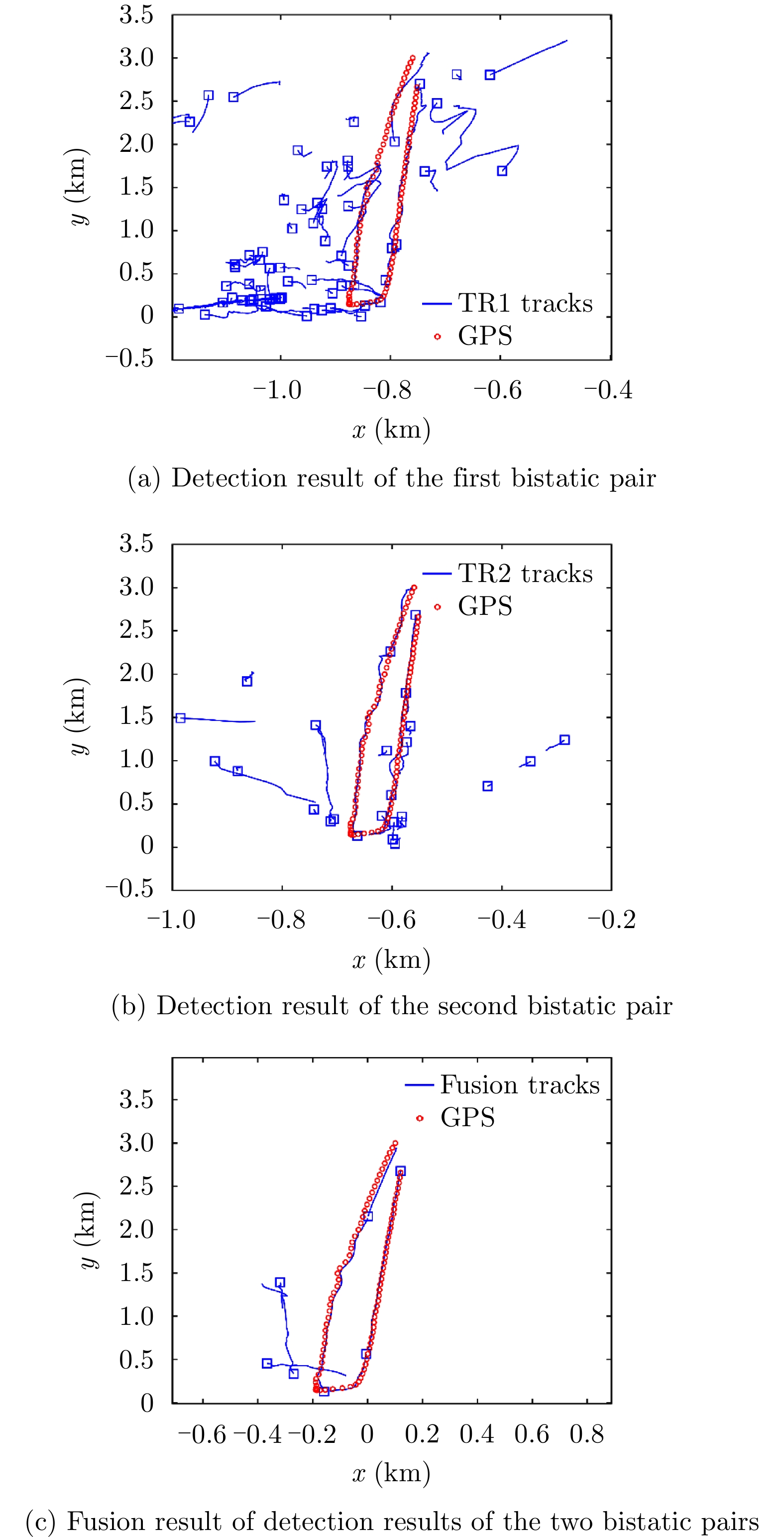| [1] |
GRIFFITH H D and BAKER C J. Passive coherent location radar systems. Part 1: Performance prediction[J]. IEE Proceedings – Radar, Sonar and Navigation, 2005, 152(3): 153–159. doi: 10.1049/ip-rsn:20045082. |
| [2] |
BAKER C J, GRIFFITHS H D, and PAPOUTSIS I. Passive coherent location radar systems. Part 2: Waveform properties[J]. IEE Proceedings – Radar, Sonar and Navigation, 2005, 152(3): 160–168. doi: 10.1049/ip-rsn:20045083. |
| [3] |
WAN Xianrong. An overview on development of passive radar based on the low frequency band digital broadcasting and TV signals[J]. Journal of Radars, 2012, 1(2): 109–123. doi: 10.3724/SP.J.1300.2012.20027. |
| [4] |
SONG Jie, HE You, CAI Fuqing, et al. Overview of passive radar technology based on non-cooperative radar illuminator[J]. Systems Engineering and Electronics, 2009, 31(9): 2151–2156, 2180. doi: 10.3321/j.issn:1001-506X.2009.09.028. |
| [5] |
KUSCHEL H, CRISTALLINI D, and OLSEN K E. Tutorial: Passive radar tutorial[J]. IEEE Aerospace and Electronic Systems Magazine, 2019, 34(2): 2–19. doi: 10.1109/MAES.2018.160146. |
| [6] |
郑恒, 王俊, 江胜利, 等. 外辐射源雷达[M]. 北京: 国防工业出版社, 2017: 1–10.
ZHENG Heng, WANG Jun, JIANG Shengli, et al. Passive Bistatic Radar[M]. Beijing: National Defense Industry Press, 2017: 1–10.
|
| [7] |
吕晓德, 仲利华, 刘忠胜, 等. 无源相参雷达系统 —原理、信号处理及设计[M]. 北京: 科学出版社, 2019: 1–22.
LV Xiaode, ZHONG Lihua, LIU Zhongsheng, et al. Passive Coherent Radar System—Principle, Signal Processing and Design[M]. Beijing: Science Press, 2019: 1–22.
|
| [8] |
GRIFFITHS H and WILLIS N. Klein Heidelberg—the first modern bistatic radar system[J]. IEEE Transactions on Aerospace and Electronic Systems, 2010, 46(4): 1571–1588. doi: 10.1109/TAES.2010.5595580. |
| [9] |
GRIFFITHS H D and LONG N R W. Television-based bistatic radar[J]. IEE Proceedings F - Communications, Radar and Signal Processing, 1986, 133(7): 649–657. doi: 10.1049/ip-f-1.1986.0104. |
| [10] |
HOWLAND P E. Target tracking using television-based bistatic radar[J]. IEE Proceedings - Radar, Sonar and Navigation, 1999, 146(3): 166–174. doi: 10.1049/ip-rsn:19990322. |
| [11] |
HOWLAND P E, MAKSIMIUK D, and REITSMA G. FM radio based bistatic radar[J]. IEE Proceedings - Radar, Sonar and Navigation, 2005, 152(3): 107–115. doi: 10.1049/ip-rsn:20045077. |
| [12] |
SAINI R and CHERNIAKOV M. DTV signal ambiguity function analysis for radar application[J]. IEE Proceedings - Radar, Sonar and Navigation, 2005, 152(3): 133–142. doi: 10.1049/ip-rsn:20045067. |
| [13] |
POULLIN D. Passive detection using digital broadcasters (DAB, DVB) with COFDM modulation[J]. IEE Proceedings - Radar, Sonar and Navigation, 2005, 152(3): 143–152. doi: 10.1049/ip-rsn:20045017. |
| [14] |
SU Weimin, GU Hong, and ZHANG Xianyi. A study on radar target detection and tracking technology based on opportunity transmitter[J]. Modern Radar, 2005, 27(4): 19–22. doi: 10.3969/j.issn.1004-7859.2005.04.006. |
| [15] |
WANG Jun, ZHANG Shouhong, and BAO Zheng. Study on the external illuminator based passive coherent radar experimental system[J]. Chinese Journal of Radio Science, 2005, 20(3): 381–385. doi: 10.3969/j.issn.1005-0388.2005.03.021. |
| [16] |
COLEMAN C and YARDLEY H. Passive bistatic radar based on target illuminations by digital audio broadcasting[J]. IET Radar, Sonar & Navigation, 2008, 2(5): 366–375. doi: 10.1049/iet-rsn:20080019. |
| [17] |
|
| [18] |
WAN Xianrong, SHAO Qihong, KE Hengyu, et al. HF passive bistatic surface wave radar based on DRM digital AM broadcast[J]. Radar Science and Technology, 2009, 7(6): 401–405. doi: 10.3969/j.issn.1672-2337.2009.06.001. |
| [19] |
|
| [20] |
ZEMMARI R, DAUN M, and NICKEL U. Maritime surveillance using GSM passive radar[C]. The 13th International Radar Symposium (IRS), Warsaw, Poland, 2012: 76–82. doi: 10.1109/IRS.2012.6233293. |
| [21] |
COLONE F, FALCONE P, BONGIOANNI C, et al. WiFi-based passive bistatic radar: Data processing schemes and experimental results[J]. IEEE Transactions on Aerospace and Electronic Systems, 2012, 48(2): 1061–1079. doi: 10.1109/TAES.2012.6178049. |
| [22] |
MA Hui, ANTONIOU M, STOVE A G, et al. Maritime moving target localization using passive GNSS-Based multistatic radar[J]. IEEE Transactions on Geoscience and Remote Sensing, 2018, 56(8): 4808–4819. doi: 10.1109/TGRS.2018.2838682. |
| [23] |
VEREMYEV V I, VOROBEV E N, and KOKORINA Y V. Feasibility study of air target detection by passive radar using satellite-based transmitters[C]. 2019 IEEE Conference of Russian Young Researchers in Electrical and Electronic Engineering, Saint Petersburg and Moscow, Russia, 2019: 154–157. doi: 10.1109/EIConRus.2019.8656630. |
| [24] |
SANTI F, PIERALICE F, and PASTINA D. Joint detection and localization of vessels at sea with a GNSS-based multistatic radar[J]. IEEE Transactions on Geoscience and Remote Sensing, 2019, 57(8): 5894–5913. doi: 10.1109/TGRS.2019.2902938. |
| [25] |
PASTINA D, SANTI F, PIERALICE F, et al. Passive radar imaging of ship targets with GNSS signals of opportunity[J]. IEEE Transactions on Geoscience and Remote Sensing, doi: 10.1109/TGRS.2020.3005306. |
| [26] |
WANG Yasen, BAO Qinglong, WANG Dinghe, et al. An experimental study of passive bistatic radar using uncooperative radar as a transmitter[J]. IEEE Geoscience and Remote Sensing Letters, 2015, 12(9): 1868–1872. doi: 10.1109/LGRS.2015.2432574. |
| [27] |
SONG Jie, CAI Fuqing, ZHANG Caisheng, et al. Experimental results of maritime moving target detection based on passive bistatic radar using non-cooperative radar illuminators[J]. The Journal of Engineering, 2019, 2019(20): 6763–6766. doi: 10.1049/joe.2019.0586. |
| [28] |
中华人民共和国国家质量监督检验检疫总局, 中国国家标准化管理委员会. GB 20600-2006 数字电视地面广播传输系统帧结构、信道编码和调制[S]. 北京: 中国标准出版社, 2007.
General Administration of the People’s Republic of China Quality Supervision and Quarantine, National Standardization Administration of China. GB 20600-2006 Framing structure, channel coding and modulation for digital television terrestrial broadcasting system[S]. Beijing: China Standard Press, 2007.
|
| [29] |
国家广播电影电视总局. GY/T 220.1-2006 移动多媒体广播 第1部分: 广播信道帧结构、信道编码和调制[S]. 中国移动多媒体标准, 2006.
State Administration of Radio, Film and Television. GY/T 220.1-2006 Mobile multimedia broadcasting part 1: Framing structure channel coding and modulation for broadcasting channel[S]. China Mobile Multimedia Broadcasting Standard, 2006.
|
| [30] |
European Telecommunication Standards Institute. ES 201 980 v3.1.1-Digital Radio Mondiale (DRM) System Specification[S]. 2009.
|
| [31] |
WANG Jun and NIU Yihua. Two algorithms for passive radar imaging based on multiple television stations[J]. Systems Engineering and Electronics, 2007, 29(8): 1263–1267. doi: 10.3321/j.issn:1001-506x.2007.08.012. |
| [32] |
GAO Zhiwen, TAO Ran, and SHAN Tao. Side peaks analysis and suppression of DVB-T signal ambiguity function for passive radar[J]. Acta Electronica Sinica, 2008, 36(3): 505–509. doi: 10.3321/j.issn:0372-2112.2008.03.018. |
| [33] |
GAO Zhiwen, TAO Ran, and SHAN Tao. Two fast algorithms of cross-ambiguity function for passive radar[J]. Acta Electronica Sinica, 2009, 37(3): 669–672. doi: 10.3321/j.issn:0372-2112.2009.03.044. |
| [34] |
GUAN Xin, HU Donghui, ZHONG Lihua, et al. An effective real-time target detection algorithm for high radial speed targets in passive radar[J]. Journal of Electronics & Information Technology, 2013, 35(3): 581–588. doi: 10.3724/SP.J.1146.2012.00903. |
| [35] |
GUAN Xin, ZHONG Lihua, HU Donghui, et al. A compensation algorithm based on RSPWVD-Hough transform for Doppler expansion in passive radar[J]. Journal of Radars, 2013, 2(4): 430–438. doi: 10.3724/SP.J.1300.2013.13073. |
| [36] |
TANG Hui, WAN Xianrong, CHEN Wei, et al. Experimentation on target detection with passive radar based on Digital Terrestrial Multimedia Broadcasting[J]. Journal of Electronics & Information Technology, 2013, 35(3): 575–580. doi: 10.3724/SP.J.1146.2012.00939. |
| [37] |
WAN Xianrong, YI Jianxin, ZHAO Zhixin, et al. Experimental research for CMMB-Based passive radar under a multipath environment[J]. IEEE Transactions on Aerospace and Electronic Systems, 2014, 50(1): 70–85. doi: 10.1109/TAES.2013.120737. |
| [38] |
MA Yahui, SHAN Tao, ZHANG Y D, et al. A novel two-dimensional sparse-weight NLMS filtering scheme for passive bistatic radar[J]. IEEE Geoscience and Remote Sensing Letters, 2016, 13(5): 676–680. doi: 10.1109/LGRS.2016.2535173. |
| [39] |
BACZYK M K and MALANOWSKI M. Reconstruction of the reference signal in DVB-T-based passive radar[J]. International Journal of Electronics and Telecommunications, 2011, 57(1): 43–48. doi: 10.2478/v10177-011-0006-y. |
| [40] |
SEARLE S, HOWARD S, and PALMER J. Remodulation of DVB-T signals for use in passive bistatic radar[C]. 2010 Conference Record of the Forty Fourth Asilomar Conference on Signals, Systems and Computers (ASILOMAR), Pacific Grove, USA, 2010: 1112–1116. doi: 10.1109/ACSSC.2010.5757576. |
| [41] |
MAHFOUDIA O, HORLIN F, and NEYT X. Optimum reference signal reconstruction for DVB-T based passive radars[C]. 2017 IEEE Radar Conference (RadarConf), Seattle, USA, 2017: 1446–1449. doi: 10.1109/RADAR.2017.7944411. |
| [42] |
MAHFOUDIA O, HORLIN F, and NEYT X. Performance analysis of the reference signal reconstruction for DVB-T passive radars[J]. Signal Processing, 2019, 158: 26–35.
|
| [43] |
BOK D. Reconstruction and reciprocal filter of OFDM waveforms for DVB-T2 based passive radar[C]. 2018 International Conference on Radar (RADAR), Brisbane, Australia, 2018: 1–6.
|
| [44] |
O’HAGAN D W, SETSUBI M, and PAINE S. Signal reconstruction of DVB-T2 signals in passive radar[C]. 2018 IEEE Radar Conference (RadarConf), Oklahoma, USA, 2018: 1111–1116. doi: 10.1109/RADAR.2018.8378717. |
| [45] |
WAN Xianrong, CEN Bo, YI Jianxin, et al. Reference signal extraction methods for CMMB-based passive bistatic radar[J]. Journal of Electronics & Information Technology, 2012, 34(2): 338–343. doi: 10.3724/SP.J.1146.2011.00572. |
| [46] |
WAN Xianrong, WANG Junfang, HONG Sheng, et al. Reconstruction of reference signal for DTMB-based passive radar systems[C]. 2011 IEEE CIE International Conference on Radar, Chengdu, China, 2011: 165–168. doi: 10.1109/CIE-Radar.2011.6159501. |
| [47] |
ZHANG Xun, YI Jianxin, WAN Xianrong, et al. Reference signal reconstruction under oversampling for DTMB-based passive radar[J]. IEEE Access, 2020, 8: 74024–74038. doi: 10.1109/ACCESS.2020.2986589. |
| [48] |
SCHWARK C and HECKENBACH J. Multi-sensor reference diversity for improved OFDM signal reconstruction[C]. 2017 IEEE Radar Conference (RadarConf), Seattle, USA, 2017: 1446–1449. doi: 10.1109/RADAR.2017.7944434. |
| [49] |
BERTHILLOT C, SANTORI A, RABASTE O, et al. BEM reference signal estimation for an airborne passive radar antenna array[J]. IEEE Transactions on Aerospace and Electronic Systems, 2017, 53(6): 2833–2845. doi: 10.1109/TAES.2017.2716458. |
| [50] |
GUO Shuai, WANG Jun, MA Hui, et al. Modified blind equalization algorithm based on cyclostationarity for contaminated reference signal in airborne PBR[J]. Sensors, 2020, 20(3): 788. doi: 10.3390/s20030788. |
| [51] |
PALMARINI C, MARTELLI T, COLONE F, et al. Disturbance removal in passive radar via sliding extensive cancellation algorithm (ECA-S)[C]. 2015 IEEE Radar Conference, Johannesburg, South Africa, 2015: 162–167. doi: 10.1109/RadarConf.2015.7411873. |
| [52] |
YI Jianxin, WAN Xianrong, LI Deshi, et al. Robust clutter rejection in passive radar via generalized subband cancellation[J]. IEEE Transactions on Aerospace and Electronic Systems, 2018, 54(4): 1931–1946. doi: 10.1109/TAES.2018.2805228. |
| [53] |
赵志欣, 万显荣, 邵启红, 等. DRM无源雷达多径杂波的分载波空域抑制[J]. 华中科技大学学报: 自然科学版, 2012, 40(3): 13–17.
ZHAO Zhixin, WAN Xianrong, SHAO Qihong, et al. Multipath clutter suppression by spatial filtering on each carrier in DRM-based passive radar[J]. Journal of Huazhong University of Science and Technology: Natural Science Edition, 2012, 40(3): 13–17.
|
| [54] |
YI Jianxin, WAN Xianrong, ZHAO Zhixin, et al. Subcarrier-based processing for clutter rejection in CP-OFDM signal-based passive radar using SFN configuration[J]. Journal of Radars, 2013, 2(1): 1–13. doi: 10.3724/SP.J.1300.2013.13030. |
| [55] |
LIU Yuqi, YI Jianxin, WAN Xianrong, et al. Evaluation of clutter suppression in CP-OFDM-based passive radar[J]. IEEE Sensors Journal, 2019, 19(14): 5572–5586. doi: 10.1109/JSEN.2019.2907660. |
| [56] |
万显荣, 刘玉琪, 程丰, 等. 基于信道分段平滑的外辐射源雷达非平稳杂波抑制方法[J]. 电子与信息学报, 2020, 42(1): 132–139. doi: 10.11999/JEIT190754. WAN Xianrong, LIU Yuqi, CHENG Feng, et al. Nonstationary clutter suppression method for passive radar based on channel segmentation and smoothing[J]. Journal of Electronic & Information Technology, 2020, 42(1): 132–139. doi: 10.11999/JEIT190754. |
| [57] |
|
| [58] |
CHABRIEL G, BARRÈRE J, GASSIER G, et al. Passive covert radars using CP-OFDM signals. A new efficient method to extract targets echoes[C]. 2014 Radar Conference, Lille, France, 2014: 1–6. doi: 10.1109/RADAR.2014.7060382. |
| [59] |
FANG Liang, WAN Xianrong, FANG Gao, et al. Passive detection using orthogonal frequency division multiplex signals of opportunity without multipath clutter cancellation[J]. IET Radar, Sonar & Navigation, 2016, 10(3): 516–524. doi: 10.1049/iet-rsn.2015.0238. |
| [60] |
FABRIZIO G, COLONE F, LOMBARDO P, et al. Adaptive beamforming for high-frequency over-the-horizon passive radar[J]. IET Radar, Sonar & Navigation, 2009, 3(4): 384–405. doi: 10.1049/iet-rsn.2008.0159. |
| [61] |
吴海洲, 陶然, 单涛. 基于DTTB照射源的无源雷达直达波干扰抑制[J]. 电子与信息学报, 2009, 31(9): 2033–2038.
WU Haizhou, TAO Ran, and SHAN Tao. Direct-path interference suppression for passive radar based on DTTB illuminator[J]. Journal of Electronics & Information Technology, 2009, 31(9): 2033–2038.
|
| [62] |
TAO R, WU H Z, and SHAN T. Direct-path suppression by spatial filtering in digital television terrestrial broadcasting-based passive radar[J]. IET Radar, Sonar & Navigation, 2010, 4(6): 791–805. doi: 10.1049/iet-rsn.2009.0138. |
| [63] |
BROWN J, WOODBRIDGE K, GRIFFITHS H, et al. Passive bistatic radar experiments from an airborne platform[J]. IEEE Aerospace and Electronic Systems Magazine, 2012, 27(11): 50–55. doi: 10.1109/MAES.2012.6380826. |
| [64] |
LIANG Long, WAN Xianrong, CHENG Feng, et al. Modeling and characteristics analysis of clutter for airborne passive radar[J]. Chinese Journal of Radio Science, 2014, 29(4): 595–600. doi: 10.13443/j.cjors.2013080601. |
| [65] |
WAN Xianrong, LIANG Long, DAN Yangpeng, et al. Experimental research of passive radar on moving platform[J]. Chinese Journal of Radio Science, 2015, 30(2): 383–390. doi: 10.13443/j.cjors.2014042301. |
| [66] |
PALMER J, UMMENHOFER M, SUMMERS A, et al. Receiver platform motion compensation in passive radar[J]. IET Radar, Sonar & Navigation, 2017, 11(6): 922–931. doi: 10.1049/iet-rsn.2016.0516. |
| [67] |
YANG Pengcheng, LYU X D, CHAI Zhihai, et al. Clutter cancellation along the clutter ridge for airborne passive radar[J]. IEEE Geoscience and Remote Sensing Letters, 2017, 14(6): 951–955. doi: 10.1109/LGRS.2017.2689076. |
| [68] |
WOJACZEK P, COLONE F, CRISTALLINI D, et al. Reciprocal-filter-based STAP for passive radar on moving platforms[J]. IEEE Transactions on Aerospace and Electronic Systems, 2019, 55(2): 967–988. doi: 10.1109/TAES.2018.2867688. |
| [69] |
BLASONE G P, COLONE F, LOMBARDO P, et al. A two-stage approach for direct signal and clutter cancellation in passive radar on moving platforms[C]. 2019 IEEE Radar Conference (RadarConf), Boston, USA, 2019: 1–6. doi: 10.1109/RADAR.2019.8835704. |
| [70] |
BLASONE G P, COLONE F, LOMBARDO P, et al. Passive radar DPCA schemes with adaptive channel calibration[J]. IEEE Transactions on Aerospace and Electronic Systems, 2020, 56(5): 4014–4034. doi: 10.1109/TAES.2020.2987478. |
| [71] |
VISWANATHAN R and VARSHNEY P K. Distributed detection with multiple sensors Part I. Fundamentals[J]. Proceedings of the IEEE, 1997, 85(1): 54–63. doi: 10.1109/5.554208. |
| [72] |
TAO Ran, GAO Zhiwen, and WANG Yue. Side peaks interference suppression in DVB-T based passive radar[J]. IEEE Transactions on Aerospace and Electronic Systems, 2012, 48(4): 3610–3619. doi: 10.1109/TAES.2012.6324746. |
| [73] |
HACK D E, PATTON L K, HIMED B, et al. Detection in passive MIMO radar networks[J]. IEEE Transactions on Signal Processing, 2014, 62(11): 2999–3012. doi: 10.1109/TSP.2014.2319776. |
| [74] |
CUI Guolong, LIU Jun, LI Hongbin, et al. Signal detection with noisy reference for passive sensing[J]. Signal Processing, 2015, 108: 389–399. doi: 10.1016/j.sigpro.2014.09.034. |
| [75] |
LIU Jun, LI Hongbin, and HIMED B. On the performance of the cross-correlation detector for passive radar applications[J]. Signal Processing, 2015, 113: 32–37. doi: 10.1016/j.sigpro.2015.01.006. |
| [76] |
ZHANG Xin, LI Hongbin, LIU Jun, et al. Joint delay and Doppler estimation for passive sensing with direct-path interference[J]. IEEE Transactions on Signal Processing, 2016, 64(3): 630–640. doi: 10.1109/TSP.2015.2488584. |
| [77] |
BIALKOWSKI K S, CLARKSON I V L, and HOWARD S D. Generalized canonical correlation for passive multistatic radar detection[C]. 2011 IEEE Statistical Signal Processing Workshop (SSP), Nice, France, 2011: 417–420. doi: 10.1109/SSP.2011.5967719. |
| [78] |
ZAIMBASHI A, DERAKHTIAN M, and SHEIKHI A. GLRT-based CFAR detection in passive bistatic radar[J]. IEEE Transactions on Aerospace and Electronic Systems, 2013, 49(1): 134–159. doi: 10.1109/TAES.2013.6404095. |
| [79] |
LIU Jun, LI Hongbin, and HIMED B. Two target detection algorithms for passive multistatic radar[J]. IEEE Transactions on Signal Processing, 2014, 62(22): 5930–5939. doi: 10.1109/TSP.2014.2359637. |
| [80] |
HACK D E, PATTON L K, HIMED B, et al. Centralized passive MIMO radar detection without direct-path reference signals[J]. IEEE Transactions on Signal Processing, 2014, 62(11): 3013–3023. doi: 10.1109/TSP.2014.2320462. |
| [81] |
GAO Yongchan, LI Hongbin, and HIMED B. Knowledge-aided range-spread target detection for distributed MIMO radar in nonhomogeneous environments[J]. IEEE Transactions on Signal Processing, 2017, 65(3): 617–627. doi: 10.1109/TSP.2016.2625266. |
| [82] |
GOGINENI S, SETLUR P, and RANGASWAMY M, et al. Random matrix theory inspired passive bistatic radar detection of low-rank signals[C]. 2015 IEEE Radar Conference (RadarConf), Arlington, USA, 2015: 1656–1659. doi: 10.1109/RADAR.2015.7131264. |
| [83] |
SETLUR P, GOGINENI S, and RANGASWAMY M. Spectral characterizations of structured big data covariance matrices[C]. 2017 IEEE Radar Conference (RadarConf), Seattle, USA, 2017: 1745–1750. doi: 10.1109/RADAR.2017.7944489. |
| [84] |
GOGINENI S, SETLUR P, RANGASWAMY M, et al. Passive radar detection with noisy reference channel using principal subspace similarity[J]. IEEE Transactions on Aerospace and Electronic Systems, 2018, 54(1): 18–36. doi: 10.1109/TAES.2017.2730998. |
| [85] |
GROSSI E, LOPS M, and VENTURINO L. A novel dynamic programming algorithm for track-before-detect in radar systems[J]. IEEE Transactions on Signal Processing, 2013, 61(10): 2608–2619. doi: 10.1109/TSP.2013.2251338. |
| [86] |
ZHANG Jiancheng, SU Tao, ZHENG Jibin, et al. Novel fast coherent detection algorithm for radar maneuvering target with jerk motion[J]. IEEE Journal of Selected Topics in Applied Earth Observations and Remote Sensing, 2017, 10(5): 1792–1803. doi: 10.1109/JSTARS.2017.2651156. |
| [87] |
WANG Hui, YI Jianxin, WAN Xianrong, et al. Greedy algorithm- based track-before-detect in radar systems[J]. IEEE Sensors Journal, 2018, 18(17): 7158–7165. doi: 10.1109/JSEN.2018.2853188. |
| [88] |
WANG Hui, YI Jianxin, and WAN Xianrong. A fast coherent integration algorithm for maneuvering target detection[J]. IEEE Sensors Journal, 2019, 19(12): 4560–4570. doi: 10.1109/JSEN.2019.2899455. |
| [89] |
COLONE F and LOMBARDO P. Polarimetric passive coherent location[J]. IEEE Transactions on Aerospace and Electronic Systems, 2015, 51(2): 1079–1097. doi: 10.1109/TAES.2014.130775. |
| [90] |
COLONE F and LOMBARDO P. Non-coherent adaptive detection in passive radar exploiting polarimetric and frequency diversity[J]. IET Radar, Sonar & Navigation, 2016, 10(1): 15–23. doi: 10.1049/iet-rsn.2015.0104. |
| [91] |
FILIPPINI F and COLONE F. A practical approach to polarimetric adaptive target detection in passive radar[C]. 2017 International Conference on Radar Systems, Belfast, UK, 2017: 1–6. doi: 10.1049/cp.2017.0420. |
| [92] |
ZAIMBASHI A, DERAKHTIAN M, and SHEIKHI A. Invariant target detection in multiband FM-based passive bistatic radar[J]. IEEE Transactions on Aerospace and Electronic Systems, 2014, 50(1): 720–736. doi: 10.1109/TAES.2013.120248. |
| [93] |
MARTELLI T, COLONE F, TILLI E, et al. Multi-frequency target detection techniques for DVB-T based passive radar sensors[J]. Sensors, 2016, 16(10): 1594. doi: 10.3390/s16101594. |
| [94] |
MARTELLI T, COLONE F, TILLI E, et al. Maritime surveillance via multi-frequency DVB-T based passive radar[C]. 2017 IEEE Radar Conference (RadarConf), Seattle, USA, 2017: 540–545. doi: 10.1109/RADAR.2017.7944262. |
| [95] |
YI Jianxin, WAN Xianrong, LEUNG H, et al. MIMO passive radar tracking under a single frequency network[J]. IEEE Journal of Selected Topics in Signal Processing, 2015, 9(8): 1661–1671. doi: 10.1109/JSTSP.2015.2464188. |
| [96] |
CHOI S, CROUSE D, WILLETT P, et al. Multistatic target tracking for passive radar in a DAB/DVB network: Initiation[J]. IEEE Transactions on Aerospace and Electronic Systems, 2015, 51(3): 2460–2469. doi: 10.1109/TAES.2015.130270. |
| [97] |
CHOI S, CROUSE D F, WILLETT P, et al. Approaches to Cartesian data association passive radar tracking in a DAB/DVB network[J]. IEEE Transactions on Aerospace and Electronic Systems, 2014, 50(1): 649–663. doi: 10.1109/TAES.2013.120431. |
| [98] |
LI Xiaohua, BAUM M, WILLETT P, et al. Evaluation of the PMHT approach for passive radar tracking with unknown transmitter associations[C]. The 17th International Conference on Information Fusion, Salamanca, Spain, 2014: 1–7.
|
| [99] |
LI Xiaohua, ZHAO Chenxu, LU Xiaofeng, et al. DA-PMHT for multistatic passive radar multitarget tracking in dense clutter environment[J]. IEEE Access, 2019, 7: 49316–49326. doi: 10.1109/ACCESS.2019.2907789. |
| [100] |
SHI Yifang and SONG T L. Sequential processing JIPDA for multitarget tracking in clutter using multistatic passive radar[C]. The 19th International Conference on Information Fusion, Heidelberg, Germany, 2016: 1–8.
|
| [101] |
STINCO P, GRECO M S, GINI F, et al. ComRadE: Cognitive passive tracking in symbiotic IEEE 802.22 systems[J]. IEEE Transactions on Aerospace and Electronic Systems, 2017, 53(2): 1023–1034. doi: 10.1109/TAES.2017.2667498. |
| [102] |
STINCO P, GRECO M S, and GINI F. Spectrum sensing and sharing for cognitive radars[J]. IET Radar, Sonar & Navigation, 2016, 10(3): 595–602. doi: 10.1049/iet-rsn.2015.0372. |
| [103] |
KUSCHEL H, UMMENHOFER M, LOMBARDO P, et al. Passive radar components of ARGUS 3D[J]. IEEE Aerospace and Electronic Systems Magazine, 2014, 29(3): 15–25. doi: 10.1109/MAES.2014.6805362. |
| [104] |
FRÄNKEN D and ZEEB O. Advances in real-time tracking and data fusion using multiple passive radar sensors[C]. The 20th International Radar Symposium, Ulm, Germany, 2019: 1–10.
|
| [105] |
STEJSKAL V, KUSCHEL H, BRENNER T, et al. DETOUR trials: The mission and its results[C]. The 18th International Radar Symposium, Prague, Czech Republic, 2017: 1–14. doi: 10.23919/IRS.2017.8008191. |
| [106] |
FRÄNKEN D and ZEEB O. Real-time creation of a target situation picture with the Hensoldt passive radar system[C]. The 21st International Conference on Information Fusion, Cambridge, UK, 2018: 500–506. doi: 10.23919/ICIF.2018.8455609. |
| [107] |
OLIVADESE D, GIUSTI E, PETRI D, et al. Passive ISAR with DVB-T signals[J]. IEEE Transactions on Geoscience and Remote Sensing, 2013, 51(8): 4508–4517. doi: 10.1109/TGRS.2012.2236339. |
| [108] |
MARTORELLA M and GIUSTI E. Theoretical foundation of passive bistatic ISAR imaging[J]. IEEE Transactions on Aerospace and Electronic Systems, 2014, 50(3): 1647–1659. doi: 10.1109/TAES.2014.130181. |
| [109] |
PISCIOTTANO I, CRISTALLINI D, and PASTINA D. Maritime target imaging via simultaneous DVB-T and DVB-S passive ISAR[J]. IET Radar, Sonar & Navigation, 2019, 13(9): 1479–1487. doi: 10.1049/iet-rsn.2018.5622. |
| [110] |
PISCIOTTANO I, SANTI F, PASTINA D, et al. DVB-S based passive polarimetric ISAR-methods and experimental validation[J]. IEEE Sensors Journal, doi: 10.1109/JSEN.2020.3037091. |
| [111] |
GROMEK D, KULPA K, and SAMCZYŃSKI P. Experimental results of passive SAR imaging using DVB-T illuminators of opportunity[J]. IEEE Geoscience and Remote Sensing Letters, 2016, 13(8): 1124–1128. doi: 10.1109/LGRS.2016.2571901. |
| [112] |
FANG Yue, ATKINSON G, SAYIN A, et al. Improved passive SAR imaging with DVB-T transmissions[J]. IEEE Transactions on Geoscience and Remote Sensing, 2020, 58(7): 5066–5076. doi: 10.1109/TGRS.2020.2972156. |
| [113] |
GROMEK D, RADECKI K, DROZDOWICZ J, et al. Passive SAR imaging using DVB-T illumination for airborne applications[J]. IET Radar, Sonar & Navigation, 2019, 13(2): 213–221. doi: 10.1049/iet-rsn.2018.5123. |
| [114] |
NITHIROCHANANONT U, ANTONIOU M, and CHERNIAKOV M. Passive multi-static SAR-experimental results[J]. IET Radar, Sonar & Navigation, 2019, 13(2): 222–228. doi: 10.1049/iet-rsn.2018.5226. |
| [115] |
SANTI F, BUCCIARELLI M, PASTINA D, et al. Passive multistatic SAR with GNSS transmitters and using joint bi/multi-static CLEAN technique[C]. 2016 IEEE Radar Conference (RadarConf), Philadelphia, USA, 2016: 1–6. doi: 10.1109/RADAR.2016.7485109. |
| [116] |
QIU Wei, GIUSTI E, BACCI A, et al. Compressive sensing-based algorithm for passive bistatic ISAR with DVB-T signals[J]. IEEE Transactions on Aerospace and Electronic Systems, 2015, 51(3): 2166–2180. doi: 10.1109/TAES.2015.130761. |
| [117] |
QU Lele, LIU Yu, AN Shimiao, et al. Multi-static airborne passive SAR imaging using cross-validation-based SOMP algorithm[J]. The Journal of Engineering, 2019, 2019(20): 7092–7095. doi: 10.1049/joe.2019.0587. |
| [118] |
BOURNAKA G, BARUZZI A, HECKENBACH J, et al. Experimental validation of beamforming techniques for localization of moving target in passive radar[C]. 2015 IEEE Radar Conference (RadarConf), Arlington, USA, 2015: 1710–1713. doi: 10.1109/RADAR.2015.7131274. |
| [119] |
EDRICH M, SCHROEDER A, and MEYER F. Design and performance evaluation of a mature FM/DAB/DVB-T multi-illuminator passive radar system[J]. IET Radar, Sonar & Navigation, 2014, 8(2): 114–122. doi: 10.1049/iet-rsn.2013.0162. |
| [120] |
EDRICH M, LUTZ S, and HOFFMANN F. Passive radar at Hensoldt: A review to the last decade[C]. The 20th International Radar Symposium (IRS), Ulm, Germany, 2019: 1–10. doi: 10.23919/IRS.2019.8768186. |
| [121] |
DI LALLO A, FARINA A, FULCOLI R, et al. AULOS: Finmeccanica family of passive sensors[J]. IEEE Aerospace and Electronic Systems Magazine, 2016, 31(11): 24–29. doi: 10.1109/MAES.2017.160037. (请联系作者确认doi信息) |
| [122] |
MARTELLI T, COLONE F, and CARDINALI R. Eco-friendly dual-band AULOS® passive radar for air and maritime surveillance applications[C]. 2018 IEEE International Conference on Environmental Engineering (EE), Milan, Italy, 2018: 1–6. doi: 10.1109/EE1.2018.8385267. |
| [123] |
|
| [124] |
RZEWUSKI S, WIELGO M, KULPA K, et al. Multistatic passive radar based on WIFI-results of the experiment[C]. 2013 International Conference on Radar, Adelaide, Australia, 2013: 230–234. doi: 10.1109/RADAR.2013.6651990. |
| [125] |
RIBÓ S, ARCO J C, OLIVERAS S, et al. Experimental results of an X-Band PARIS receiver using Digital Satellite TV opportunity signals scattered on the sea surface[J]. IEEE Transactions on Geoscience and Remote Sensing, 2014, 52(9): 5704–5711. doi: 10.1109/TGRS.2013.2292007. |
| [126] |
RAJA ABDULLAH R S A, SALAH A A, ISMAIL A, et al. Experimental investigation on target detection and tracking in passive radar using long-term evolution signal[J]. IET Radar, Sonar & Navigation, 2016, 10(3): 577–585. doi: 10.1049/iet-rsn.2015.0346. |
| [127] |
COLONE F, MARTELLI T, BONGIOANNI C, et al. WiFi-based PCL for monitoring private airfields[J]. IEEE Aerospace and Electronic Systems Magazine, 2017, 32(2): 22–29. doi: 10.1109/MAES.2017.160022. |
| [128] |
PASTINA D, SANTI F, PIERALICE F, et al. Maritime moving target long time integration for GNSS-based passive bistatic radar[J]. IEEE Transactions on Aerospace and Electronic Systems, 2018, 54(6): 3060–3083. doi: 10.1109/TAES.2018.2840298. |
| [129] |
SANTI F, PASTINA D, ANTONIOU M, et al. GNSS-based multistatic passive radar imaging of ship targets[C]. 2020 IEEE International Radar Conference (RADAR), Washington, USA, 2020: 601–606. doi: 10.1109/RADAR42522.2020.9114638. |
| [130] |
WAN Xianrong, ZHAO Zhixin, KE Hengyu, et al. Experimental research of HF passive radar based on DRM digital AM broadcasting[J]. Journal of Radars, 2012, 1(1): 11–18. doi: 10.3724/SP.J.1300.2013.20001. |
| [131] |
ZHAO Zhixin, WAN Xianrong, ZHANG Delei, et al. An experimental study of HF passive bistatic radar via hybrid sky-surface wave mode[J]. IEEE Transactions on Antennas and Propagation, 2013, 61(1): 415–424. doi: 10.1109/TAP.2012.2213062. |
| [132] |
YI Jianxin, WAN Xianrong, CHENG Feng, et al. Computationally efficient RF interference suppression method with closed-form maximum likelihood estimator for HF surface wave over-the-horizon radars[J]. IEEE Transactions on Geoscience and Remote Sensing, 2013, 51(4): 2361–2372. doi: 10.1109/TGRS.2012.2210903. |
| [133] |
XIE Rui, WAN Xianrong, HONG Li’na, et al. Effects of the travelling ionospheric disturbance on sky-surface wave passive radar system[J]. Chinese Journal of Radio Science, 2014, 29(6): 1098–1104, 1152. doi: 10.13443/j.cjors.2013103102. |
| [134] |
ZHAO Zhixin, WAN Xianrong, YI Jianxin, et al. Radio frequency interference mitigation in OFDM based passive bistatic radar[J]. AEU – International Journal of Electronics and Communications, 2016, 70(1): 70–76. doi: 10.1016/j.aeue.2015.10.004. |
| [135] |
XIE Rui, WAN Xianrong, ZHAO Zhixin, et al. Localization method and accuracy analysis in hybrid sky-surface wave passive radar[J]. Chinese Journal of Radio Science, 2014, 29(3): 442–449. doi: 10.13443/j.cjors.2013060902. |
| [136] |
张强, 万显荣, 傅䶮, 等. 基于CDR数字音频广播的外辐射源雷达信号模糊函数分析与处理[J]. 雷达学报, 2014, 3(6): 702–710. doi: 10.12000/JR14050. ZHANG Qiang, WAN Xianrong, FU Yan, et al. Ambiguity function analysis and processing for passive radar based on CDR digital audio broadcasting[J]. Journal of Radars, 2014, 3(6): 702–710. doi: 10.12000/JR14050. |
| [137] |
FU Yan, WAN Xianrong, ZHANG Xun, et al. Side peak interference mitigation in FM-based passive radar via detection identification[J]. IEEE Transactions on Aerospace and Electronic Systems, 2017, 53(2): 778–788. doi: 10.1109/TAES.2017.2665079. |
| [138] |
YI Jianxin, WAN Xianrong, LEUNG H, et al. Joint placement of transmitters and receivers for distributed MIMO radars[J]. IEEE Transactions on Aerospace and Electronic Systems, 2017, 53(1): 122–134. doi: 10.1109/TAES.2017.2649338. |
| [139] |
LÜ Min, YI Jianxin, WAN Xianrong, et al. Cochannel interference in DTMB-Based passive radar[J]. IEEE Transactions on Aerospace and Electronic Systems, 2019, 55(5): 2138–2149. doi: 10.1109/TAES.2018.2882959. |
| [140] |
WEN Jinfang, YI Jianxin, and WAN Xianrong. Sparse representation for target parameter estimation in CDR-based passive radar[J]. IEEE Geoscience and Remote Sensing Letters, doi: 10.1109/LGRS.2020.2991743. |
| [141] |
LIU Yuqi, WAN Xianrong, TANG Hui, et al. Digital television based passive bistatic radar system for drone detection[C]. 2017 IEEE Radar Conference (RadarConf), Seattle, USA, 2017: 1493–1497. doi: 10.1109/RADAR.2017.7944443. |
| [142] |
SHU Kan, YI Jianxin, WAN Xianrong, et al. A hybrid tracking algorithm for multistatic passive radar[J]. IEEE Systems Journal, in press. doi: 10.1109/JSYST.2020.2994009 |
| [143] |
LÜ Min, YI Jianxin, WAN Xianrong, et al. Target tracking in time-division-multifrequency-based passive radar[J]. IEEE Sensors Journal, 2020, 20(8): 4382–4394. doi: 10.1109/JSEN.2020.2964291. |
| [144] |
FANG Gao, YI Jianxin, WAN Xianrong, et al. Experimental research of multistatic passive radar with a single antenna for drone detection[J]. IEEE Access, 2018, 6: 33542–33551. doi: 10.1109/ACCESS.2018.2844556. |
| [145] |
SALAH A A, RAJA ABDULLAH R S A, ISMAIL A, et al. Experimental study of LTE signals as illuminators of opportunity for passive bistatic radar applications[J]. Electronics Letters, 2014, 50(7): 545–547. doi: 10.1049/el.2014.0237. |
| [146] |
KLÖCK C, WINKLER V, and EDRICH M. LTE-signal processing for passive radar air traffic surveillance[C]. The 18th International Radar Symposium (IRS), Prague, Czech Republic, 2017: 1–9. doi: 10.23919/IRS.2017.8008105. |
| [147] |
王本静, 易建新, 万显荣, 等. LTE外辐射源雷达帧间模糊带分析与抑制[J]. 雷达学报, 2018, 7(4): 514–522. doi: 10.12000/JR18025. WANG Benjing, YI Jianxin, WAN Xianrong, et al. Inter-frame ambiguity analysis and suppression of LTE signal for passive radar[J]. Journal of Radars, 2018, 7(4): 514–522. doi: 10.12000/JR18025. |
| [148] |
DAN Yangpeng, YI Jianxin, WAN Xianrong, et al. LTE-based passive radar for drone detection and its experimental results[J]. The Journal of Engineering, 2019, 2019(20): 6910–6913. doi: 10.1049/joe.2019.0583. |
| [149] |
万显荣, 刘同同, 易建新, 等. LTE外辐射源雷达系统设计及目标探测实验研究[J]. 雷达学报. 2020, 9(6): 967–973.
WAN Xianrong, LIU Tongtong, YI Jianxin, et al. System design and target detection experiments for LTE-based passive radar[J]. Journal of Radar. 2020, 9(6): 967–973.
|
| [150] |
FRÄNKEN D and ZEEB O. Tracking and data fusion with the Hensoldt passive radar system[C]. The 22nd International Microwave and Radar Conference, Poznan, Poland, 2018: 404–407. doi: 10.23919/MIKON.2018.8405238. |
| [151] |
CONTE E, D’ADDIO E, FARINA A, et al. Multistatic radar detection: Synthesis and comparison of optimum and suboptimum receivers[J]. IEE Proceedings F - Communications, Radar and Signal Processing, 1983, 130(6): 484–494. doi: 10.1049/ip-f-1:19830078. |
| [152] |
ZHANG Xin, LI Hongbin, and HIMED B. Multistatic detection for passive radar with direct-path interference[J]. IEEE Transactions on Aerospace and Electronic Systems, 2017, 53(2): 915–92. doi: 10.1109/TAES.2017.2667223. |
| [153] |
MALANOWSKI M and KULPA K. Two methods for target localization in multistatic passive radar[J]. IEEE Transactions on Aerospace and Electronic Systems, 2012, 48(1): 572–580. doi: 10.1109/TAES.2012.6129656. |
| [154] |
NOROOZI A and SEBT M A. Target localization in multistatic passive radar using SVD approach for eliminating the nuisance parameters[J]. IEEE Transactions on Aerospace and Electronic Systems, 2017, 53(4): 1660–1671. doi: 10.1109/TAES.2017.2669558. |
| [155] |
NOROOZI A and SEBT M A. Algebraic solution for three-dimensional TDOA/AOA localisation in multiple-input- multiple-output passive radar[J]. IET Radar, Sonar & Navigation, 2018, 12(1): 21–29. doi: 10.1049/iet-rsn.2017.0117. |
| [156] |
KLEIN M and MILLET N. Multireceiver passive radar tracking[J]. IEEE Aerospace and Electronic Systems Magazine, 2012, 27(10): 26–36. doi: 10.1109/MAES.2012.6373909. |
| [157] |
BATTISTELLI G, CHISCI L, MORROCCHI S, et al. Robust multisensor multitarget tracker with application to passive multistatic radar tracking[J]. IEEE Transactions on Aerospace and Electronic Systems, 2012, 48(4): 3450–3472. doi: 10.1109/TAES.2012.6324726. |
| [158] |
KUSCHEL H, HECKENBACH J, and SCHELL J. Deployable multiband passive/active radar for air defense (DMPAR)[J]. IEEE Aerospace and Electronic Systems Magazine, 2013, 28(9): 37–45. doi: 10.1109/MAES.2013.6617097. |
| [159] |
RADMARD M, KARBASI S M, and NAYEBI M N. Data fusion in MIMO DVB-T-Based passive coherent location[J]. IEEE Transactions on Aerospace and Electronic Systems, 2013, 49(3): 1725–1737. doi: 10.1109/TAES.2013.6558015. |
| [160] |
STINCO P, GRECO M S, GINI F, et al. Posterior Cramér–Rao lower bounds for passive bistatic radar tracking with uncertain target measurements[J]. Signal Processing, 2013, 93(12): 3528–3540. doi: 10.1016/j.sigpro.2013.02.021. |
| [161] |
XIE Rui, WAN Xianrong, HONG Sheng, et al. Joint optimization of receiver placement and illuminator selection for a multiband passive radar network[J]. Sensors, 2017, 17(6): 1378. doi: 10.3390/s17061378. |
| [162] |
DEL-REY-MAESTRE N, JARABO-AMORES M P, MATA-MOYA D, et al. Machine learning techniques for coherent CFAR detection based on statistical modeling of UHF passive ground clutter[J]. IEEE Journal of Selected Topics in Signal Processing, 2018, 12(1): 104–118. doi: 10.1109/JSTSP.2017.2780798. |
| [163] |
CLEMENTE C, PARRY T, GALSTON G, et al. GNSS based passive bistatic radar for micro-Doppler based classification of helicopters: Experimental validation[C]. 2015 IEEE Radar Conference, Arlington, USA, 2015: 1104–1108. doi: 10.1109/RADAR.2015.7131159. |
| [164] |
YONEL B, MASON E, and YAZICI B. Deep learning for passive synthetic aperture radar[J]. IEEE Journal of Selected Topics in Signal Processing, 2018, 12(1): 90–103. doi: 10.1109/JSTSP.2017.2784181. |
| [165] |
MANNO-KOVACS A, GIUST E, BERIZZI F, et al. Image based robust target classification for passive ISAR[J]. IEEE Sensors Journal, 2019, 19(1): 268–276. doi: 10.1109/JSEN.2018.2876911. |
| [166] |
YAO Shiying, YI Jianxin, WAN Xianrong, et al. Multi-frame joint detection for passive radar based on multi-layer perceptron[J/OL]. Chinese Journal of Radio Science. https://doi.org/10.13443/j.cjors.2020022301, 2020. |




 Submit Manuscript
Submit Manuscript Peer Review
Peer Review Editor Work
Editor Work





 DownLoad:
DownLoad:


